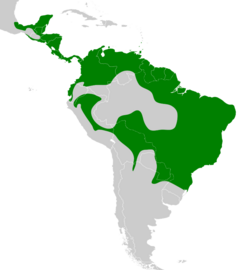Biology:Yellow-bellied elaenia
| Yellow-bellied elaenia | |
|---|---|

| |
| At Registro, São Paulo State, Brazil | |
| Scientific classification | |
| Domain: | Eukaryota |
| Kingdom: | Animalia |
| Phylum: | Chordata |
| Class: | Aves |
| Order: | Passeriformes |
| Family: | Tyrannidae |
| Genus: | Elaenia |
| Species: | E. flavogaster
|
| Binomial name | |
| Elaenia flavogaster (Thunberg, 1822)
| |
| Subspecies | |
|
4, see text | |

| |
The yellow-bellied elaenia (Elaenia flavogaster) is a small bird of the tyrant flycatcher family. It breeds from southern Mexico and the Yucatán Peninsula through Central and South America as far as northern Argentina , and on Trinidad and Tobago.
Description
Adults are 16.5 cm (6.5 in) long and weigh 24 g (0.85 oz). They have olive-brown upperparts, a white eye ring, a bushy divided crest and a white crown patch in the parting. The throat is pale and the breast greyish, with pale yellow lower underparts. The call is a nasal breeer, and the song is a wheezing zhu-zhee-zhu-zhee.
Subspecies
Four subspecies are recognized:[2]
- Elaenia flavogaster subpagana – Sclater, PL, 1860: found from southeastern Mexico to Costa Rica and on Coiba Island, Panama
- Elaenia flavogaster pallididorsalis – Aldrich, 1937: found in Panama
- Elaenia flavogaster flavogaster – (Thunberg, 1822): nominate, found in Colombia, Venezuela, Trinidad, and the southern Lesser Antilles, the Guianas, Brazil except western and central Amazonas, southeastern Peru, Bolivia, Paraguay and northeastern Argentina
- Elaenia flavogaster semipagana – Sclater, PL, 1862: found in southwestern Colombia, western and southern Ecuador and northwestern Peru
Habitat
This is a common bird in semi-open woodland, scrub, gardens and cultivation. The yellow-bellied elaenia is a noisy and conspicuous bird which feeds on berries and insects. The latter are usually caught from mid-air after the bird sallies from a perch, and sometimes picked up from plants.[3] The species will also join mixed-species feeding flocks on occasion, typically staying quite some distance up in the trees.[4]
It makes a cup nest and lays two cream eggs with reddish blotches at the larger end. The female incubates for 16 days, with about the same period to fledging. Omnivorous mammals as small as the common marmoset (Callithrix jacchus) will eagerly plunder yellow-bellied elaenia nests in the undergrowth—perhaps more often during the dry season when fruits are scarce—despite the birds' attempts to defend their offspring.[5]
Conservation status
The yellow-bellied elaenia is a common and wide-ranging bird, not considered threatened by the IUCN.[1]
References
- ↑ Jump up to: 1.0 1.1 BirdLife International (2016). "Elaenia flavogaster". IUCN Red List of Threatened Species 2016: e.T22699262A93721824. doi:10.2305/IUCN.UK.2016-3.RLTS.T22699262A93721824.en. https://www.iucnredlist.org/species/22699262/93721824. Retrieved 11 November 2021.
- ↑ Gill, F.; Donsker, D., eds (2014). "IOC World Bird List". IOC World Bird List (V 4.2). doi:10.14344/IOC.ML.4.2. http://www.worldbirdnames.org.
- ↑ de A. Gabriel, Vagner; Pizo, Marco A. (2005). "Foraging behavior of tyrant flycatchers (Aves, Tyrannidae) in Brazil" (in English, Portuguese). Revista Brasileira de Zoologia 22 (4): 1072–1077. doi:10.1590/S0101-81752005000400036. http://www.scielo.br/pdf/rbzool/v22n4/a36v22n4.pdf.
- ↑ Machado, C.G. (1999). "A composição dos bandos mistos de aves na Mata Atlântica da Serra de Paranapiacaba, no sudeste brasileiro" (in Portuguese, English). Revista Brasileira de Biologia 59 (1): 75–85. doi:10.1590/S0034-71081999000100010. http://www.scielo.br/pdf/rbbio/v59n1/v59n1a10.pdf.
- ↑ de Lyra-Neves, Rachel M.; Oliveira, Maria A.B.; Telino-Júnior, Wallace R.; dos Santos, Ednilza M. (2007). "Comportamentos interespecíficos entre Callithrix jacchus (Linnaeus) (Primates, Callitrichidae) e algumas aves de Mata Atlântica, Pernambuco, Brasil" (in Portuguese, English). Revista Brasileira de Zoologia 24 (3): 709–716. doi:10.1590/S0101-81752007000300022. http://www.scielo.br/pdf/rbzool/v24n3/a22v24n3.pdf.
Further reading
- Skutch, Alexander F. (1960). "Yellow-bellied elaenia". Life Histories of Central American Birds II. Pacific Coast Avifauna, Number 34. Berkeley, California: Cooper Ornithological Society. pp. 287–306. https://sora.unm.edu/sites/default/files/journals/pca/pca_034.pdf#page=288.
External links
- BirdLife species factsheet for Elaenia flavogaster
- "Yellow-bellied elaenia media". Internet Bird Collection. http://www.hbw.com/ibc/species/yellow-bellied-elaenia-elaenia-flavogaster.
- Yellow-bellied elaenia photo gallery at VIREO (Drexel University)
- Yellow-bellied elaenia Stamps[Usurped!] from Grenada, Saint Vincent and the Grenadines, Suriname at bird-stamps.org[Usurped!]
Wikidata ☰ Q684078 entry
 |



